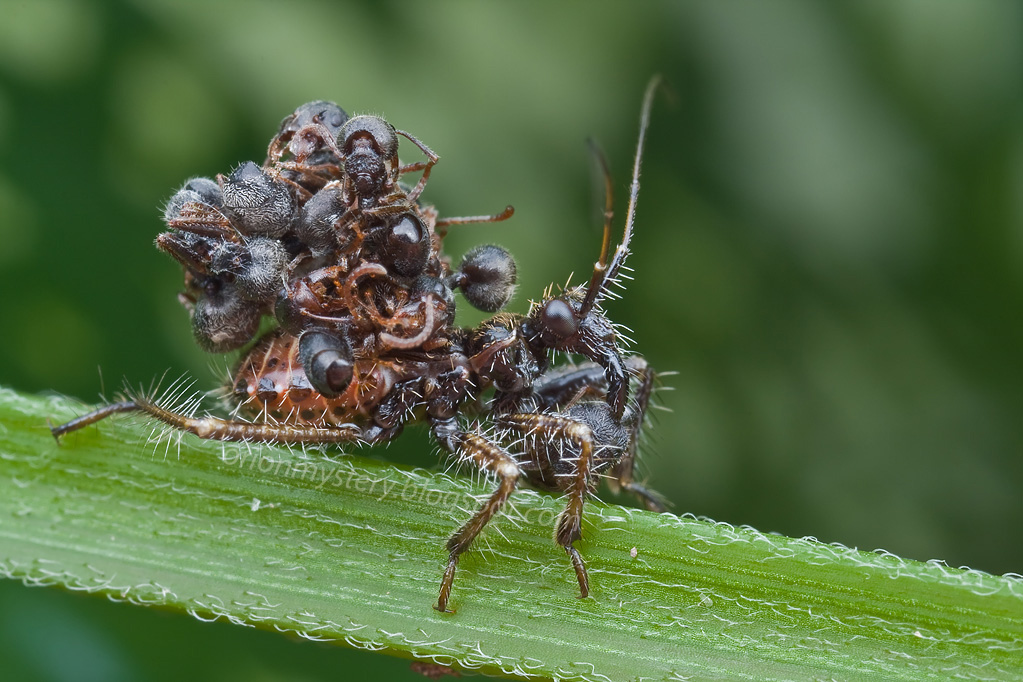In the shadowy world of insects, few creatures are as chilling as the assassin bug that adorns itself with the remains of its victims. This remarkable predator doesn’t just kill for survival—it fashions a grotesque armor from the corpses of its prey, creating one of nature’s most unsettling yet fascinating displays of evolutionary ingenuity. The sight of this tiny terror, draped in a macabre collection of ant bodies, spider husks, and other fallen insects, would make even the most hardened entomologist pause in wonder. This behavior, known as debris-carrying or corpse-cloaking, represents millions of years of evolutionary refinement that transforms these bugs into walking graveyards. But behind this horrifying exterior lies a complex survival strategy that reveals the brutal beauty of natural selection at its most creative.
Meet the Acanthaspis petax: Nature’s Most Morbid Decorator
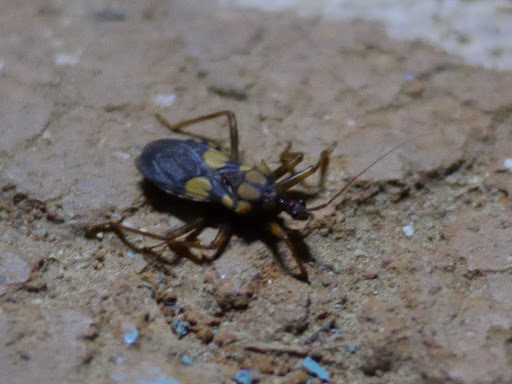
The Acanthaspis petax, commonly known as the masked assassin bug, stands as the undisputed champion of corpse-wearing among insects. This Malaysian species has perfected the art of adorning itself with the dried remains of its victims, creating a backpack of death that would make horror movie directors envious. The bug carefully selects and arranges the corpses of ants, termites, and other small insects on its back, securing them with a special adhesive secretion.
What makes this behavior truly remarkable is the precision with which these bugs curate their macabre collection. They don’t simply pile bodies haphazardly—instead, they arrange them in specific patterns that maximize both camouflage and intimidation. The dried corpses can remain attached for weeks, creating a shifting museum of the bug’s hunting prowess that grows more impressive with each successful kill.
The Science Behind the Corpse Cloak
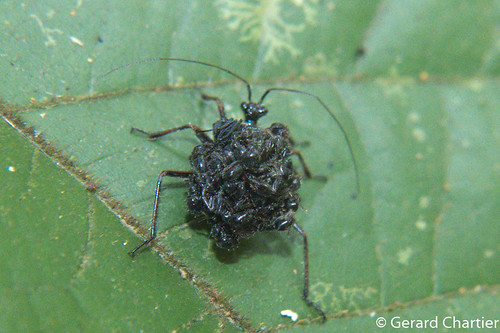
Scientists have discovered that the corpse-carrying behavior serves multiple evolutionary purposes that extend far beyond simple intimidation. The primary function appears to be chemical camouflage—the decomposing bodies release pheromones and scents that mask the assassin bug’s own odor signature. This olfactory disguise allows the predator to approach unsuspecting prey without triggering their chemical alarm systems.
Research has shown that bugs carrying corpses are significantly more successful at hunting than their unadorned counterparts. The dead bodies also provide physical protection, acting as armor against attacks from other predators and even creating a buffer zone that makes it harder for prey to land effective defensive strikes. The weight of the corpses, rather than hindering movement, actually helps stabilize the bug during hunting maneuvers.
How Assassin Bugs Craft Their Deadly Wardrobe

The process of corpse-attachment is a meticulous ritual that begins immediately after a successful kill. The assassin bug uses specialized glands to secrete a powerful adhesive that bonds the victim’s body to specific attachment points on its back and sides. This biological glue is remarkably durable, withstanding rain, wind, and the violent struggles of subsequent prey.
The bug demonstrates surprising selectivity in its corpse collection, often rejecting certain victims based on size, species, or condition. Researchers have observed these insects spending considerable time positioning and repositioning bodies to achieve optimal coverage and balance. The entire process can take several minutes per corpse, revealing a level of behavioral complexity that challenges our understanding of insect cognition.
The Psychological Warfare of Wearing Death
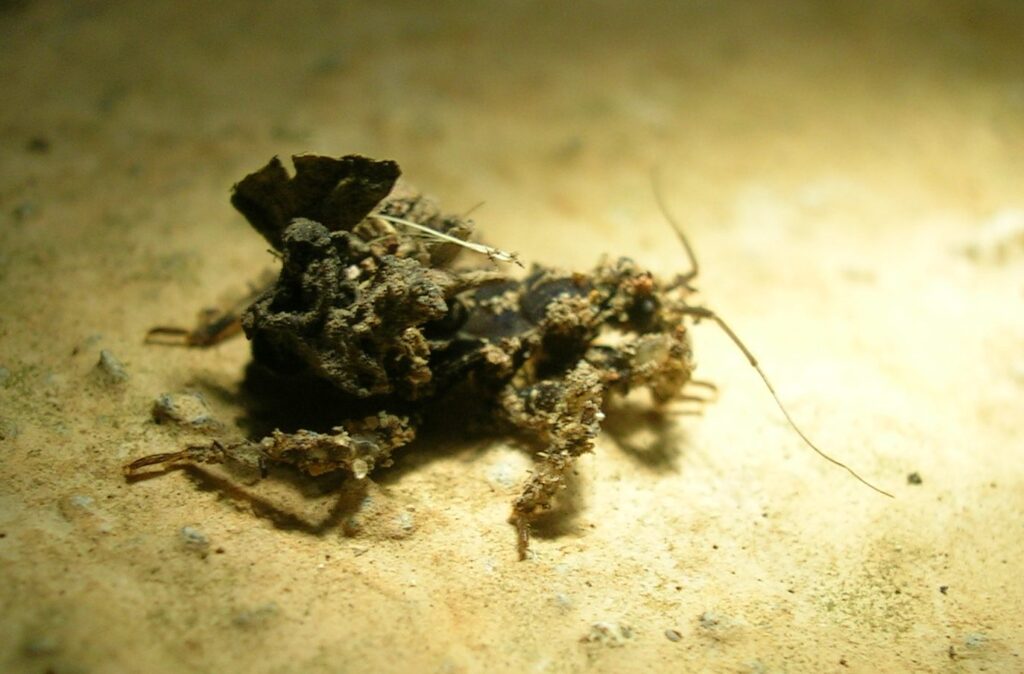
Beyond camouflage and protection, the corpse cloak serves as a powerful psychological weapon that terrorizes potential prey. Many insects possess innate fear responses to the sight and smell of their deceased kin, and the assassin bug exploits this primal terror to its advantage. The walking cemetery creates a moving monument to the predator’s lethal capabilities, advertising its dangerous nature to any creature that encounters it.
This psychological intimidation often causes prey to freeze in terror, making them easier targets for the assassin bug’s lightning-fast strike. The sight of dozens of corpses arranged on a single predator creates a visceral impact that transcends species boundaries—even humans experience an instinctive revulsion when confronted with these macabre displays.
Evolution’s Twisted Genius: Why This Behavior Developed
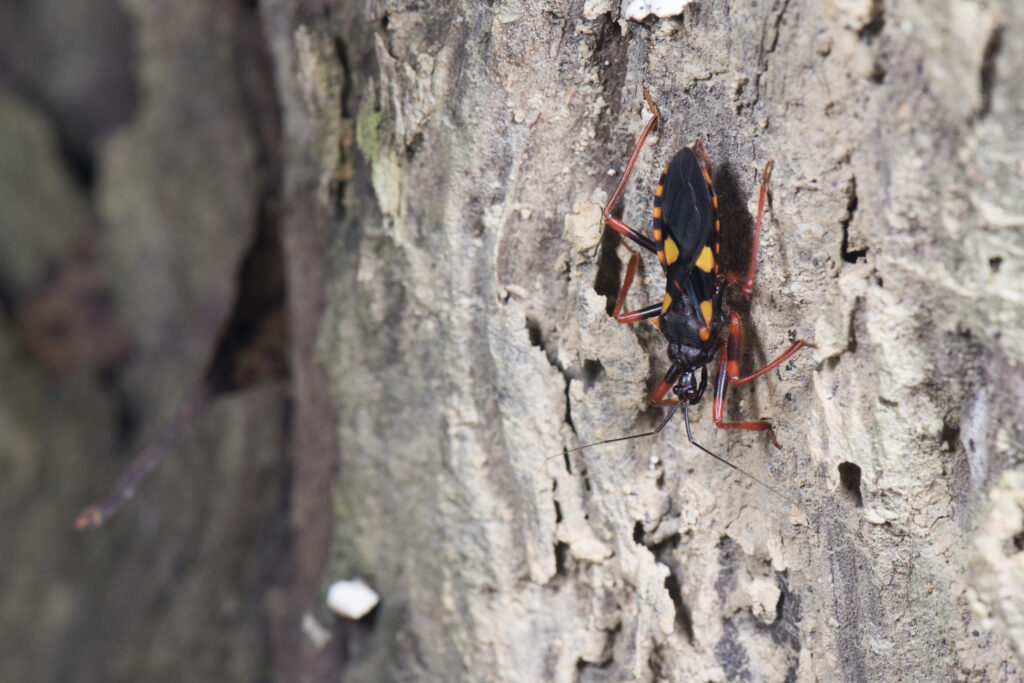
The evolution of corpse-carrying behavior represents a fascinating case study in how extreme survival pressures can drive seemingly bizarre adaptations. Scientists believe this behavior evolved in response to the fierce competition for food resources in tropical environments, where every advantage means the difference between life and death. The bugs that accidentally retained corpses on their bodies survived better, leading to the gradual refinement of this ghoulish strategy.
Genetic studies suggest that the corpse-carrying behavior involves multiple coordinated traits, including specialized glands for adhesive production, behavioral modifications for corpse selection and placement, and even changes in body structure to accommodate the extra weight. This complex suite of adaptations demonstrates how natural selection can craft solutions that seem impossibly intricate yet perfectly suited to their environment.
The Hunting Techniques of Corpse-Cloaked Predators
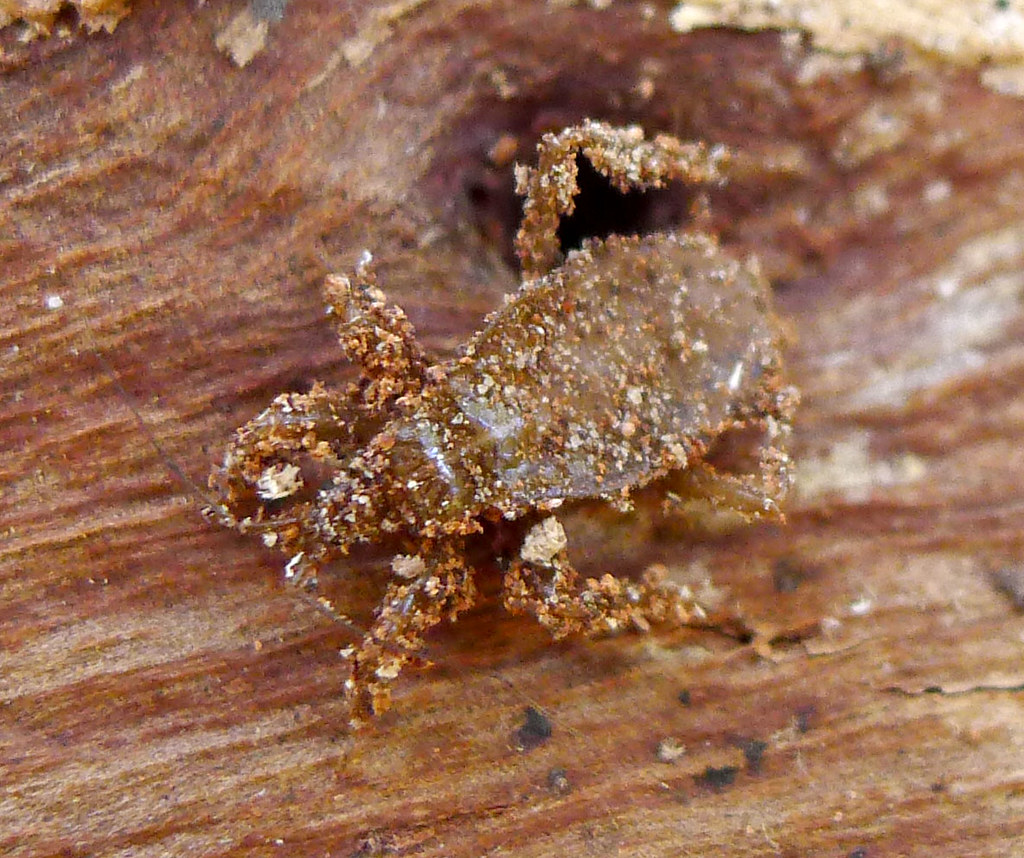
Armed with their gruesome armor, masked assassin bugs employ hunting strategies that would make military tacticians proud. They use their corpse cloak to infiltrate ant colonies, moving slowly and deliberately to avoid detection while their chemical camouflage does its work. Once inside enemy territory, they strike with surgical precision, using their needle-like proboscis to inject paralytic venom.
The most chilling aspect of their hunting behavior is their patience—these bugs can remain motionless for hours, waiting for the perfect moment to strike. Their corpse cloak provides such effective camouflage that they often become invisible even to trained researchers, appearing to materialize from thin air when they finally make their move.
Prey Selection and Corpse Curation
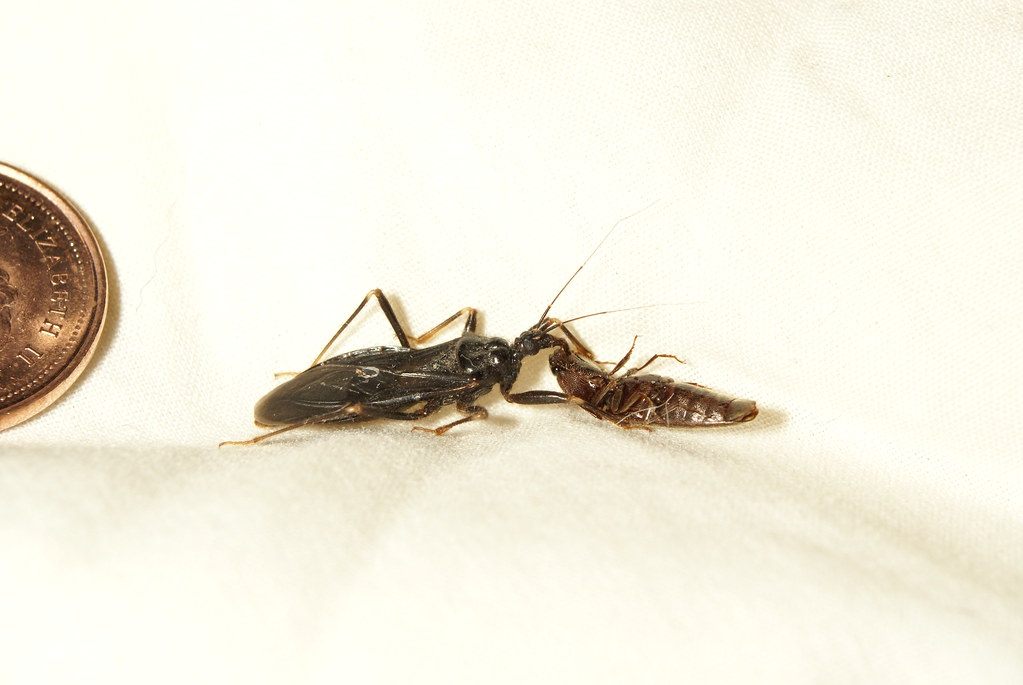
Not all victims make it onto the assassin bug’s macabre fashion statement—these predators are surprisingly selective about which corpses deserve a place in their collection. Ants appear to be the preferred choice, likely due to their abundance and the strong chemical signals they produce even after death. The bugs show particular preference for soldier ants, whose larger size and distinctive appearance create more intimidating displays.
Researchers have documented instances where assassin bugs actually compete for the “best” corpses, engaging in tugs-of-war over particularly desirable specimens. This behavior suggests that corpse quality plays a crucial role in the bug’s survival success, with premium bodies commanding premium positions on the predator’s back.
The Anatomy of Death: How Bodies Are Arranged
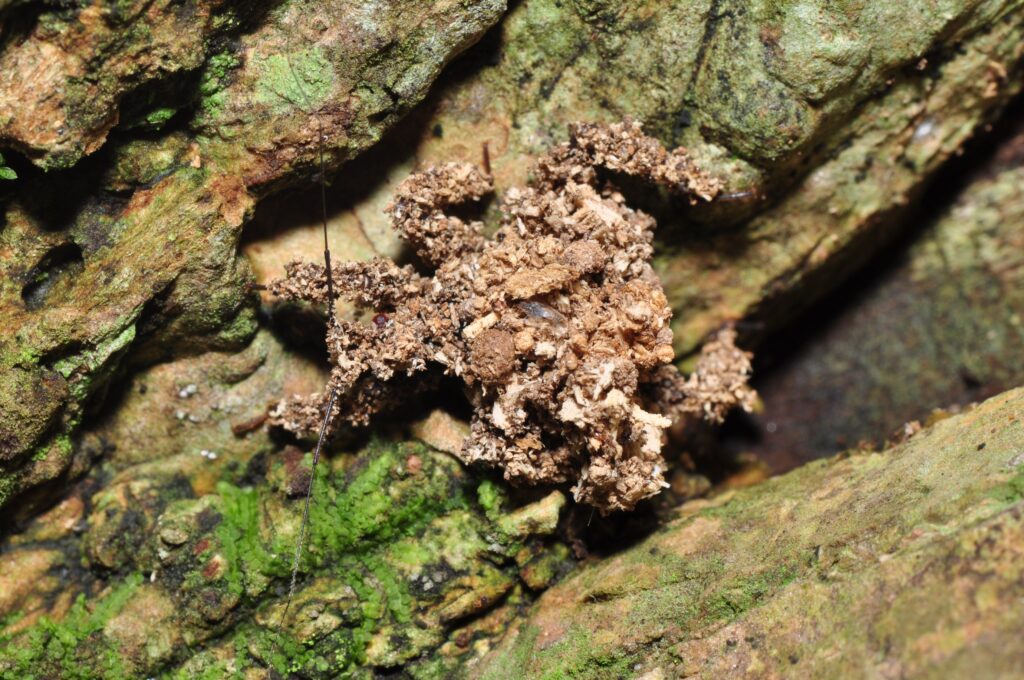
The spatial organization of corpses on an assassin bug’s back follows surprisingly consistent patterns that maximize both protection and mobility. The largest bodies typically occupy the center of the back, providing core protection for vital organs, while smaller corpses fill in the gaps around the edges. This arrangement creates a dome-like structure that deflects attacks from multiple angles.
The positioning also serves aerodynamic purposes, with the bug arranging bodies to minimize wind resistance during flight. Some specimens have been observed with over twenty corpses arranged in perfect symmetry, creating geometric patterns that seem almost artistic in their precision. The fact that these arrangements emerge from instinctive behavior rather than conscious design makes them even more remarkable.
Chemical Warfare: The Scent of Death as Camouflage

The olfactory component of corpse-carrying behavior represents one of nature’s most sophisticated chemical warfare systems. As the bodies decompose, they release a complex cocktail of compounds that serve multiple functions beyond simple camouflage. These chemical signals can actually manipulate the behavior of potential prey, causing them to lower their guard or even approach the predator voluntarily.
Scientists have identified over thirty different chemical compounds released by the decomposing corpses, each serving specific purposes in the bug’s survival strategy. Some compounds mimic alarm pheromones, causing confusion among social insects, while others replicate food attractants that lure unsuspecting victims within striking range. This chemical mastery demonstrates the incredible complexity hidden within seemingly simple behaviors.
Defense Mechanisms: When the Hunter Becomes the Hunted
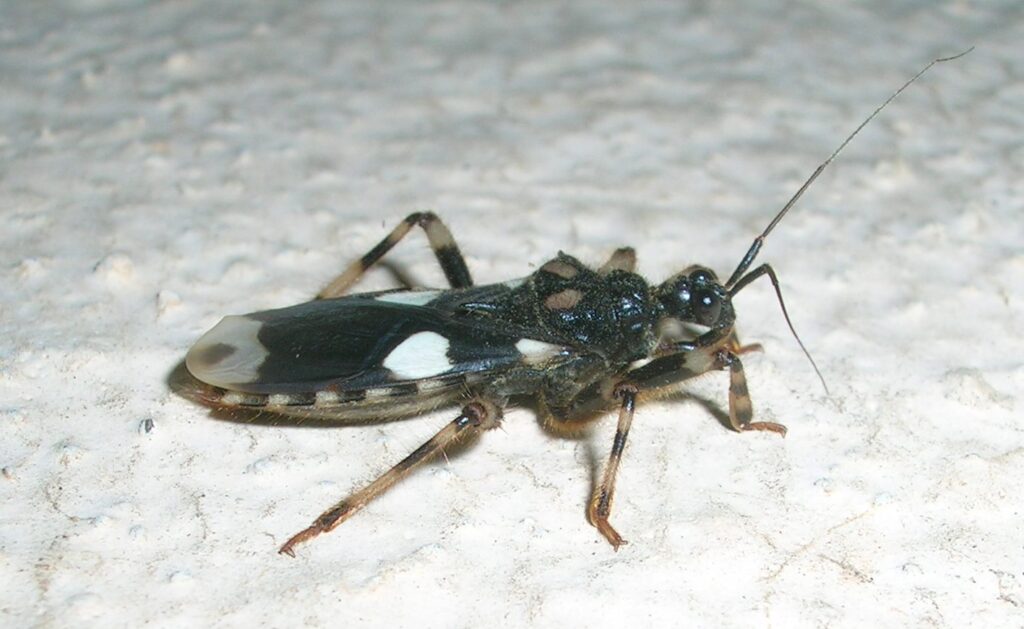
The corpse cloak provides remarkable protection when assassin bugs face their own predators, creating a multi-layered defense system that has evolved over millions of years. The dried bodies act as physical shields, absorbing the impact of attacks and making it difficult for predators to locate the bug’s vulnerable body parts. Birds and spiders often find themselves confused by the mass of corpses, unable to identify where the actual prey begins.
Perhaps most ingeniously, the corpse cloak can serve as a decoy system, allowing the bug to escape while predators waste time attacking the attached bodies. Some researchers have observed assassin bugs deliberately shedding corpses when under attack, creating a diversion that facilitates their escape. This behavior demonstrates a level of tactical thinking that challenges traditional notions of insect intelligence.
Global Distribution and Habitat Preferences

Corpse-carrying assassin bugs inhabit tropical and subtropical regions across the globe, with different species developing unique variations of the behavior based on local environmental pressures. The Malaysian Acanthaspis petax represents the most extreme example, but similar behaviors have been documented in species from Africa, South America, and Southeast Asia. Each population has adapted its corpse-carrying strategy to the specific prey species and predator threats in its environment.
These bugs typically prefer habitats with high insect diversity, such as tropical forests, gardens, and agricultural areas where prey is abundant. The warm, humid conditions in these environments also help preserve the corpses, maintaining their effectiveness as camouflage and protection for extended periods. Climate change is beginning to affect these delicate ecosystems, potentially disrupting the complex relationships that make corpse-carrying behavior possible.
Ecological Impact and Ecosystem Roles
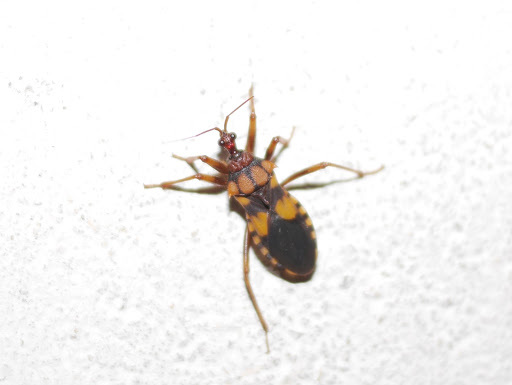
Despite their horrifying appearance, corpse-carrying assassin bugs play crucial roles in maintaining ecological balance within their ecosystems. They serve as important population control agents for many pest species, including agricultural pests that can cause significant economic damage. Their presence in gardens and farms can reduce the need for chemical pesticides, making them valuable allies in sustainable agriculture.
The bugs also contribute to nutrient cycling by breaking down and redistributing organic matter throughout their environment. Their unique behavior creates mobile death monuments that slowly decompose as they move through the ecosystem, distributing nutrients in patterns that would be impossible through normal decomposition processes. This ecological function demonstrates how even the most bizarre behaviors can serve important environmental purposes.
Recent Research and Scientific Discoveries

Recent advances in microscopy and behavioral analysis have revealed new details about corpse-carrying behavior that continue to amaze researchers. High-speed photography has captured the precise mechanics of corpse attachment, showing how the bugs can secure a new victim to their collection in less than thirty seconds. Scientists have also discovered that some species actually groom their corpse collections, removing damaged bodies and rearranging their displays to maintain optimal effectiveness.
Genetic research has identified specific genes responsible for corpse-carrying behavior, opening new avenues for understanding how complex behaviors evolve. These findings suggest that the behavior involves more genetic coordination than previously thought, with multiple genes working together to produce the specialized glands, behaviors, and body modifications necessary for successful corpse-carrying. Current studies are exploring how these genetic networks might be manipulated for pest control applications.
Conservation Challenges and Future Threats
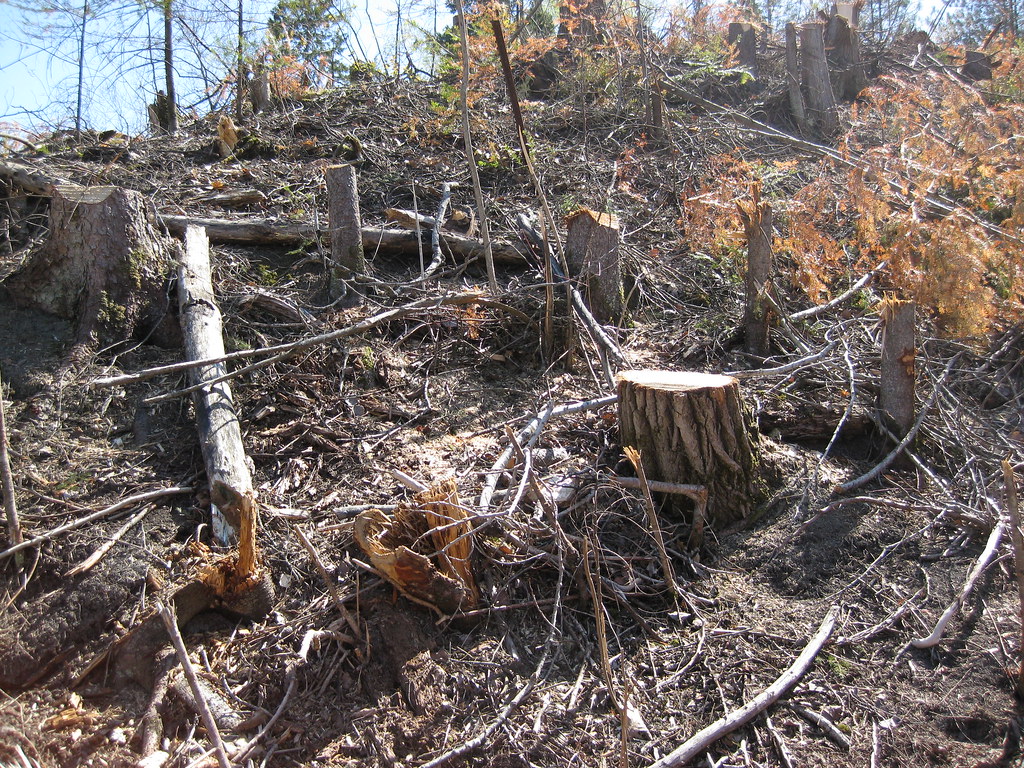
The specialized nature of corpse-carrying behavior makes these assassin bugs particularly vulnerable to environmental changes and habitat destruction. Their dependence on specific prey species and environmental conditions means that even small disruptions can have cascading effects on their populations. Deforestation, pesticide use, and climate change all pose significant threats to these remarkable predators.
Conservation efforts face unique challenges because these bugs are often viewed as pests rather than valuable ecosystem components. Their grotesque appearance and predatory behavior make them difficult to champion in conservation campaigns, despite their ecological importance. Researchers are working to educate the public about the crucial roles these insects play in maintaining healthy ecosystems and controlling pest populations.
Conclusion
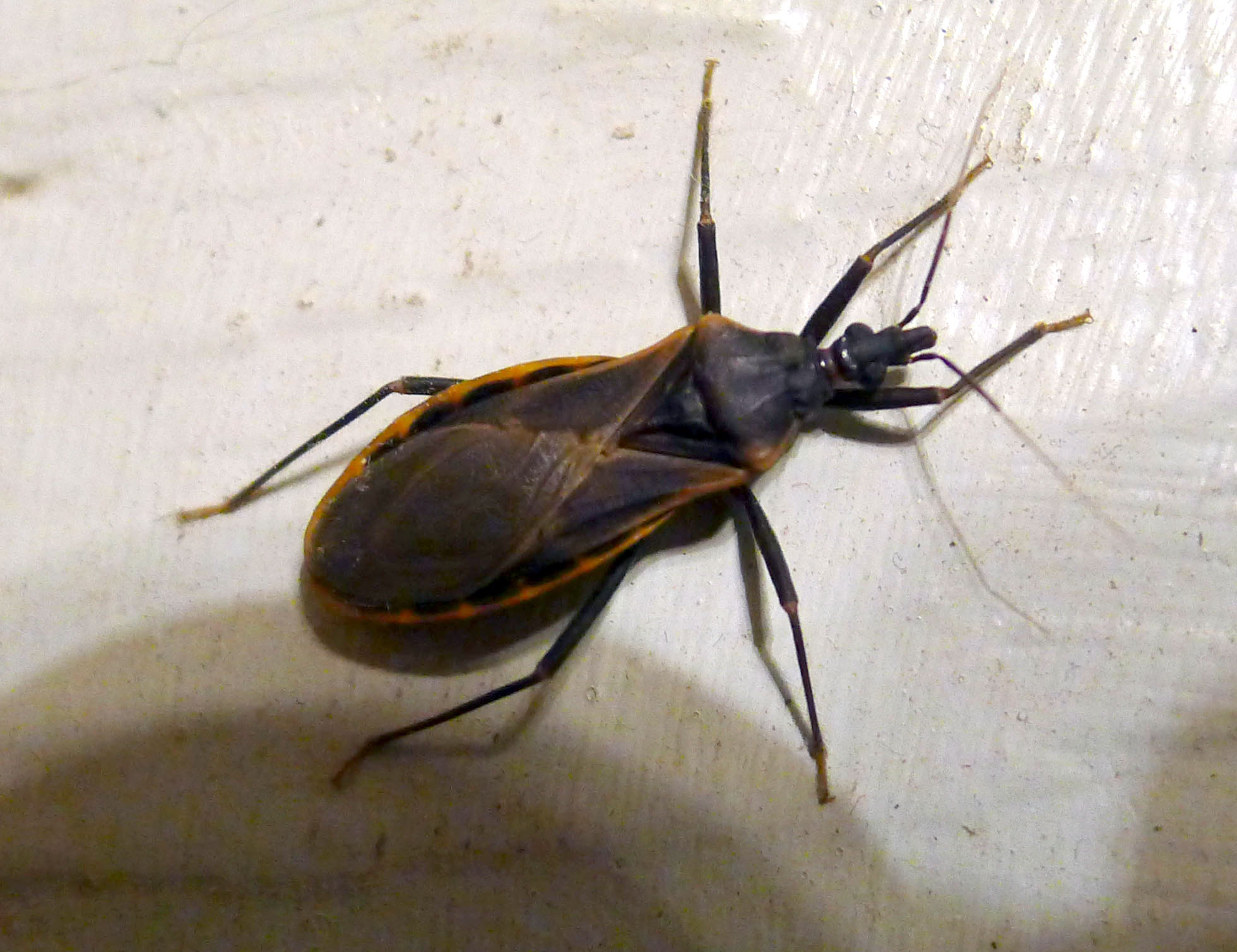
The corpse-carrying assassin bug represents one of nature’s most extraordinary examples of evolutionary innovation, transforming death into a tool for survival in ways that challenge our understanding of insect behavior. These remarkable predators have evolved complex strategies that combine chemistry, psychology, and physics to create one of the most effective hunting systems in the animal kingdom. Their ability to fashion protection and camouflage from their victims’ remains demonstrates the incredible creativity of natural selection when faced with extreme survival pressures.
As we continue to study these fascinating creatures, we gain deeper insights into the intricate web of relationships that define our natural world. The masked assassin bug reminds us that even the most disturbing behaviors in nature often serve essential ecological functions, maintaining the delicate balance that allows ecosystems to thrive. What other secrets might these walking graveyards reveal about the hidden complexity of the insect world?

